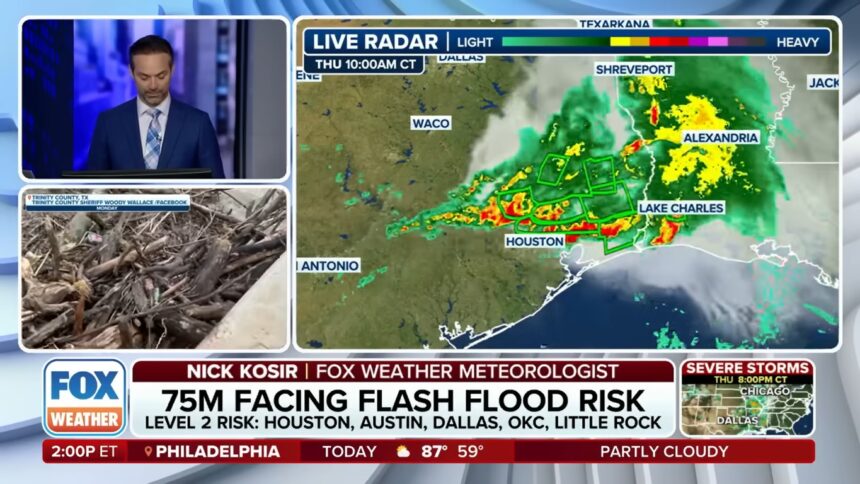Torrential rainfall and severe weather have unleashed life-threatening flooding across Southeast Texas, prompting mandatory evacuations for thousands of residents.
As of May 3, 2024, Governor Greg Abbott has declared a disaster for over 40 counties, urging Texans in at-risk areas to heed the guidance of local authorities and avoid hazardous flood conditions.
Rivers Swell to Dangerous Levels
The relentless rain, which began on Sunday, has caused rivers and streams to overflow their banks, inundating neighborhoods and forcing residents to flee their homes.
In Polk County, north of Houston, the Trinity River has reached major flood stage, with officials ordering evacuations for low-lying areas.
The river, regulated by the Lake Livingston dam, is projected to crest at 49 feet by Friday, three feet below the record set during Hurricane Harvey in 2017.
Meanwhile, the East Fork of the San Jacinto River is nearing 78 feet above sea level, just three feet below Harvey’s peak.
Harris County Judge Lina Hidalgo has issued a mandatory evacuation for residents along the river, urging them to leave before nightfall. “This is a critical situation,” Hidalgo warned during a press conference.
Widespread Power Outages and Road Closures
The severe weather has also caused widespread power outages, with over 60,000 customers without electricity across Texas as of Thursday morning.
CenterPoint Energy reported nearly 20,000 outages in Harris County alone. Downed trees and power lines have contributed to the outages, with some areas expected to remain without power for 24 to 36 hours.
Flooding has also led to numerous road closures, making travel treacherous. The Texas Department of Transportation has closed sections of major highways, including US 59 and FM 1485, due to high water. Officials are urging residents to avoid flooded areas and heed “turn around, don’t drown” warnings.
Echoes of Hurricane Harvey
For many Texans, the current flooding evokes painful memories of Hurricane Harvey, which devastated the state in 2017.
The catastrophic storm claimed 103 lives and caused an estimated $125 billion in damage. In the aftermath, Texas lawmakers launched a statewide flood plan to assess vulnerability and prioritize mitigation projects.
Despite these efforts, experts warn that climate change is increasing the frequency and intensity of extreme weather events.
As the Gulf of Mexico warms and sea levels rise, the Houston area remains particularly vulnerable to flooding.
Ongoing Response and Recovery Efforts
As floodwaters continue to rise, state and local officials are working around the clock to coordinate response efforts.
The Texas Division of Emergency Management has deployed high-water vehicles, boats, and helicopters to assist with rescues.
Shelters have been established in Harris and Polk Counties to provide refuge for those displaced by the flooding.
Looking ahead, the road to recovery will be long and challenging. Residents will need support to rebuild their homes and lives, while communities must grapple with the long-term impacts of repeated flooding.
“Climate change-fuelled impacts are hitting communities that don’t have the resources,” noted Kristy Dahl, a senior climate resilience policy analyst at the Union of Concerned Scientists.
“Low income, historically disadvantaged communities are hit first and worst.”
As Texas begins the arduous process of recovery, the focus must remain on building resilience and preparing for an increasingly uncertain future.
Through investments in mitigation, improved land-use planning, and a commitment to equitable recovery, the state can work to protect its most vulnerable residents and chart a path forward in the face of a changing climate.
Check Also: North Texas Man Loses $30,000 in Social Media Car Buying Scam





